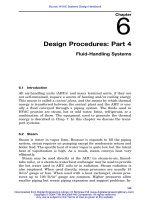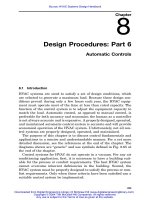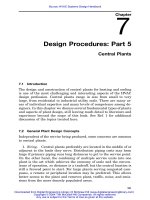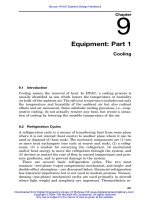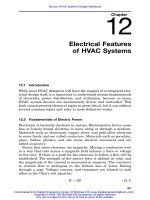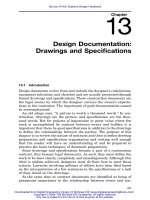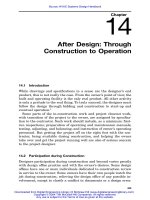Tài liệu HVAC Systems Design Handbook part 4 pdf
Bạn đang xem bản rút gọn của tài liệu. Xem và tải ngay bản đầy đủ của tài liệu tại đây (115.64 KB, 14 trang )
81
Chapter
4
Design Procedures: Part 2
General Concepts for Equipment Selection
4.1 Introduction
The purpose of this chapter is to outline the criteria used in the HVAC
system and equipment selection process, to describe some of the sys-
tems and equipment available, and to develop some of the underlying
philosophy and background related to system selection.
Details of specific systems and items of equipment are discussed in
later chapters.
4.2 Criteria for System and
Equipment Selection
The problem-solving process requires some criteria that can be applied
in describing and evaluating alternatives. In the selection of HVAC
systems, the following criteria (Table 4.1) are used—consciously or
unconsciously—because only rarely is the problem-solving process for-
mally applied.
1. Requirements of comfort or process. These requirements include
temperature, always; humidity, ventilation, and pressurization, some-
times; and zoning for better control, if needed. In theory at least, the
comfort requirement should have a high priority. In practice, this cri-
terion is sometimes subordinated to first cost or to the desires of some-
one in authority. This is happening less often as building occupants
become more sophisticated in their expectations. Process requirements
are more difficult and require a thorough inquiry by the HVAC de-
signer into the process and its needs. Until the process is fully under-
Source: HVAC Systems Design Handbook
Downloaded from Digital Engineering Library @ McGraw-Hill (www.digitalengineeringlibrary.com)
Copyright © 2004 The McGraw-Hill Companies. All rights reserved.
Any use is subject to the Terms of Use as given at the website.
82 Chapter Four
TABLE 4.1 Criteria for HVAC System and
Equipment Selection
1. Demands of comfort or process
2. Energy conservation, code requirements
3. First cost versus life-cycle cost
4. Desires of owner, architect, and/ or design office
5. Space limitations
6. Maintainability/ reliability
7. Central plant versus distributed systems
8. Simplicity and controllability
stood, the designer cannot provide an adequate HVAC system. Most
often, different parts of the process have different temperature, hu-
midity, pressure, and cleanliness requirements; the most extreme of
these can penalize the entire HVAC system.
2. Energy conservation. This is usually a code requirement and
not optional. State and local building codes almost invariably include
requirements constraining the use of new, nonrenewable energy. Non-
renewable refers primarily to fossil-fuel sources. Renewable sources
include solar power, wind, water, geothermal, waste processing, heat
reclaim, and the like. The strictest codes prohibit any form of reheat
(except from reclaimed or renewable sources) unless humidity control
is essential. This restriction eliminates such popular systems as ter-
minal reheat, two-deck multizone, multizone, and constant volume
dual-duct systems, although the two-fan dual-duct system is still pos-
sible and the three-duct multizone system is acceptable (see Chap. 11).
Most HVAC systems for process environments have opportunities for
heat reclaim and other ingenious ways of conserving energy. Off-peak
thermal storage systems are becoming popular for energy cost savings,
although these systems may actually consume more energy than con-
ventional systems.
1
Thermal storage is a variation on the age-old prac-
tice of cutting and storing ice from the lake in winter, for later use in
the summer.
3. First cost and life-cycle cost. The first cost reflects only the ini-
tial price, installed and ready to operate. The first cost ignores such
factors as expected life, ease of maintenance, and even, to some extent,
efficiency, although most energy codes require some minimum effi-
ciency rating. The life-cycle cost includes all cost factors (first cost,
operation, maintenance, replacement, and estimated energy use) and
can be used to evaluate the total cost of the system over a period of
years. A common method of comparing the life-cycle costs of two or
more systems is to convert all costs to present-worth values. Typically,
first cost governs in buildings being built for speculation or short-term
investment. Life-cycle costs are most often used by institutional
Design Procedures: Part 2
Downloaded from Digital Engineering Library @ McGraw-Hill (www.digitalengineeringlibrary.com)
Copyright © 2004 The McGraw-Hill Companies. All rights reserved.
Any use is subject to the Terms of Use as given at the website.
Design Procedures: Part 2 83
builders—schools, hospitals, government—and owners who expect to
occupy the building for an indefinite extended period. Life-cycle cost
analysis requires the assumption of an interest, or discount, rate and
may also include anticipated inflation.
4. Desires of owner, architect, or design office. Very often, someone
in authority lays down guidelines which must be followed by the de-
signer. This is particularly true for institutional owners and major
retailers. Here the designer’s job is to follow the criteria of the em-
ployer or the client unless it is obvious that some requirements are
unsuitable in an unusual environment. Examples of such environ-
mental conditions are extremely high or low outside-air humidity, high
altitude (which affects the AHU and air-cooled condenser capacity),
and contaminated outside air (which may require special filtration and
treatment).
5. Space limitations. Architects can influence the HVAC system
selection by the space they make available in a new building. In re-
trofit situations, designers must work with existing space. Sometimes
in existing buildings it is necessary to take additional space to provide
a suitable HVAC system. For example, in adding air conditioning to a
school, it is often necessary to convert a classroom to an equipment
room. Rooftop systems are another alternative where space is limited,
if the building structure will support such systems. In new buildings,
if space is too restricted, it is desirable to discuss the implications of
the space limitations in terms of equipment efficiency and maintain-
ability with the architect. There are ways of providing a functional
HVAC system in very little space, such as individual room units and
rooftop units, but these systems often have a high life-cycle cost.
6. Maintainability. This criterion includes equipment quality (the
mean time between failures is commonly used); ease of maintenance
(are high-maintenance items readily accessible in the unit?); and ac-
cessibility (Is the unit readily accessible? Is there adequate space
around it for removing and replacing items?). Rooftop units may be
readily accessible if an inside stair and a roof penthouse exist; but if
an outside ladder must be climbed, the adjective readily must be de-
leted. Many equipment rooms are easy to get to but are too small for
adequate access or maintenance. This criterion is critical in the life-
cycle cost analysis and in the long-term satisfaction of the building
owner and occupants.
7. Central plant versus distributed systems. Central plants may in-
clude only a chilled water source, both heating and chilled water, an
intermediate temperature water supply for individual room heat
pumps, or even a large, central air-handling system. Many buildings
have no central plant. This decision is, in part, influenced by previ-
ously cited criteria and is itself a factor in the life-cycle cost analysis.
Design Procedures: Part 2
Downloaded from Digital Engineering Library @ McGraw-Hill (www.digitalengineeringlibrary.com)
Copyright © 2004 The McGraw-Hill Companies. All rights reserved.
Any use is subject to the Terms of Use as given at the website.
84 Chapter Four
In general, central plant equipment has a longer life than packaged
equipment and can be operated more efficiently. The disadvantages
include the cost of pumping and piping or, for the central AHU, longer
duct systems and more fan horsepower. There is no simple answer to
this choice. Each building must be evaluated separately.
8. Simplicity and controllability. Although listed last, this is the
most important criterion in terms of how the system will really work.
There is an accepted truism that operators will soon reduce the HVAC
system and controls to their level of understanding. This is not to
criticize the operator, who may have had little or no instruction about
the system. It is simply a fact of life. The designer who wants or needs
to use a complex system must provide for adequate training—and
retraining—for operators. The best rule is: Never add an unnecessary
complication to the system or its controls.
4.3 Options in System and
Equipment Selection
Many of the various systems and equipment available are described
in later chapters. They are briefly listed here to summarize the options
available to the designer.
4.3.1 Air-handling units
Air-handling units (AHUs) include factory-assembled package units
and field-erected, built-up units (see Chap. 11). The common compo-
nents are a fan or fans, cooling and/or heating coils, and air filters.
Most units also include a mixing chamber with outside and return air
connections with dampers. The size range is from small fan-coil units
with as little as 100 ft
3
/min capacity to built-up systems handling over
100,000 ft
3
/min. When a package unit includes a cooling source, such
as a refrigeration compressor and condenser, or a heating source, such
as a gas-fired heater or electric heating coil, or both, then the unit is
said to be self-contained. This classification includes heat pumps.
Many systems for rooftop mounting are self-contained, with capacities
as great as 100 tons or more of cooling and a comparable amount of
heating. Some room units for wall or window installation have capac-
ities as small as 0.5 or 0.75 ton. Split-system packages are also avail-
able, with the heating and /or cooling source section matching the fan-
coil section but installed outdoors. The two sections are connected by
piping. Cooling coils may use chilled water, brine, or refrigerant (direct
expansion). Heating coils may use steam or high- or low-temperature
water; or ‘‘direct-fired’’ heating may be used, usually gas or electric
resistance. Heat reclaim systems of various types are employed. Hu-
midification equipment includes the steam grid, evaporative, and
Design Procedures: Part 2
Downloaded from Digital Engineering Library @ McGraw-Hill (www.digitalengineeringlibrary.com)
Copyright © 2004 The McGraw-Hill Companies. All rights reserved.
Any use is subject to the Terms of Use as given at the website.
Design Procedures: Part 2 85
slinger/atomizer types. Dehumidification equipment includes the de-
humidifying effect of most cooling coils as well as absorption-type de-
humidifiers.
Thus, the designer has a wide range of equipment to choose from.
Although generalizations are dangerous, some general rules may be
applied, but the designer must also develop, through experience, an
understanding of the best and worst choices. There are some criteria
which are useful:
1. Packaged equipment should be tested, rated, and certified in ac-
cordance with standards of American Society of Heating, Refrigera-
tion, and Air Conditioning Engineers (ASHRAE), Air Conditioning
and Refrigeration Institute (ARI), Association of Home Appliance
Manufacturers (AHAM), Air Movement and Control Association
(AMCA), and/or others as applicable.
2. Minimum unit efficiencies or effectiveness should be in accord-
ance with codes or higher.
3. In general, packaged equipment has a lower first cost and a
shorter life than equipment used in built-up systems. This is not al-
ways true, and comparisons must be made for the specific application.
4. In general, packaged equipment is designed to be as small as
possible for a given capacity. This may create problems of access for
maintenance. Also the supplier should show that capacity ratings
were determined for the package as assembled and not just for the
separate components. See particularly the discussion on the effects of
geometry on fan performance in Chap. 5.
5. In hotel guest rooms, motels and apartments, individual room
units should be used to give occupants maximum control of their en-
vironment. Where many people share the same space, central systems
are preferable, with controls which cannot be reset by occupants.
6. Noise is a factor in almost any HVAC installation, yet noise is
often neglected in equipment selection and installation. Noise ratings
are available for all types of HVAC equipment and should be used in
design and specifications (see Chap. 20).
4.3.2 Radiant and convective heating
and cooling
Convector radiators, using steam or hot water, are one of the oldest
heating methods and are still in common use. Modern systems are
more compact than the old cast-iron radiators and depend more on
natural convection than on radiation. Rating methods are standard-
ized by the Hydronics Institute.
Radiant heating by means of floor, wall, or ceiling panels is common.
Hot-water piping or electric resistance heating tape is used. Maximum
Design Procedures: Part 2
Downloaded from Digital Engineering Library @ McGraw-Hill (www.digitalengineeringlibrary.com)
Copyright © 2004 The McGraw-Hill Companies. All rights reserved.
Any use is subject to the Terms of Use as given at the website.
86 Chapter Four
temperatures of the surface must be limited, and there are some con-
trol problems, particularly in floor panels, due to the mass of the
panel.
Radiant cooling by means of wall or ceiling panels may also be used.
Surface temperatures must be kept above the dew point; therefore,
any dehumidification required must be accomplished by other means.
In modern practice, radiant and/or convective heating or cooling is
usually a supplement to the air system and is used primarily to offset
exterior wall, roof, and radiant floor heat gains or losses.
4.3.3 Refrigeration equipment
Source cooling equipment includes refrigeration compressors of re-
ciprocating, centrifugal, and screw types; absorption chillers using
steam, hot water, or direct fuel firing; water chiller heat exchangers;
condensers cooled by air, water, and evaporation; cooling towers; and
evaporative coolers, including spray, slinger, and drip types (see
Chap. 9).
Self-contained package AHUs typically use direct-expansion cooling
with reciprocating or rotary compressors. Other AHUs may use direct
expansion, chilled water, or brine cooling, with the cooling medium
provided by a separate, centralized, refrigeration system (see Chap.
6). Evaporative cooling is used primarily in climates with low design
ambient wet-bulb temperatures, although it may be used in almost
any climate to achieve some cooling. Evaporative cooler efficiencies are
highest for the spray type and lowest for the drip type. Centrifugal
and screw-type compressors and absorption refrigeration are used al-
most entirely in large central-station water or brine chillers. Absorp-
tion refrigeration may be uneconomical unless there is an adequate
source of waste heat or solar energy. Air-cooled condensers are less
costly to purchase and maintain than cooling towers or evaporative
condensers, but they result in higher peak condensing temperatures
at design conditions and may result in lower overall efficiency in the
cooling system.
The selection of the source cooling equipment is influenced primarily
by the selection of the AHU equipment and systems. Often both are
selected at the same time. The use of individual room units does not
preclude the use of central-station chillers; this combination may be
preferable in many situations. For off-peak cooling with storage, a cen-
tral chilling plant is an essential item.
4.3.4 Heating equipment
Source heating equipment includes central plant boilers for steam and
high-, medium-, and low-temperature hot water; heat pumps, both
Design Procedures: Part 2
Downloaded from Digital Engineering Library @ McGraw-Hill (www.digitalengineeringlibrary.com)
Copyright © 2004 The McGraw-Hill Companies. All rights reserved.
Any use is subject to the Terms of Use as given at the website.
Design Procedures: Part 2 87
Figure 4.1 Single-zone draw-through air-handling unit.
central and unitary; direct-fired heaters; solar equipment, including
solar-assisted heat pumps; and geothermal and heat reclaim. Fuels
include coal, oil, natural and manufactured gas, and peat. Waste prod-
ucts such as refuse-derived fuel (RDF) and sawdust are also being used
in limited ways. Electricity for resistance heating is not a fuel in the
combustion sense but is a heat source. Heat reclaim takes many forms,
some of which are discussed in Chap. 10.
Self-contained package AHUs use direct-fired heaters—usually gas
or electric—or heat pumps. For other systems, some kind of central
plant equipment is needed. The type of equipment and fuel used is
determined on the basis of the owner’s criteria, local availability and
comparative cost of fuels, and, to some extent, the expertise of the
designer. Large central plants for high-pressure steam or high-
temperature hot water, may present safety problems, are regulated by
codes and require special expertise on the part of the designer, con-
tractor, and operator. New buildings connected to existing central
plants will require the use of heat exchangers, secondary pumping or
condensate return pumping, and an understanding of limitations im-
posed by the existing plant, such as limitations on the pressure and
temperature of returned water or condensate.
4.4 The Psychrometric Chart
When the system type has been selected and a summary completed,
showing design CFM, temperature difference (TD), and latent load, it
is time to complete the psychrometric chart. For a detailed discussion
of psychrometrics, see Chap. 19. Consider a single-zone, draw-through
air-handling system, as in Fig. 4.1. In summer the return air is mixed
with some minimum amount of outside air; is pulled through the filter,
the coils, and the fan; and is supplied to the space. Cooling is provided
by the cooling coil through the use of chilled water (as in this example)
Design Procedures: Part 2
Downloaded from Digital Engineering Library @ McGraw-Hill (www.digitalengineeringlibrary.com)
Copyright © 2004 The McGraw-Hill Companies. All rights reserved.
Any use is subject to the Terms of Use as given at the website.
88 Chapter Four
Figure 4.2 Psychrometric chart, cooling cycle example.
or by direct refrigerant expansion. On the psychrometric chart (Fig.
4.2), the designer first plots the inside and outside design
conditions—say 75ЊF and 50 percent RH inside and 95ЊF dry bulb (db),
75ЊF wet bulb (wb) outside. The return air to the system will usually
be at a higher temperature than the space due to heat gains in return-
air plenums. (This does not hold for direct-return units.) This heat
gain can be estimated or calculated from the geometry of the building,
the wattage of recessed lighting, etc. For this example, assume a 3ЊF
rise. Then the return air is at 78ЊF with the same humidity ratio w
as the space. A straight line between this point and the outside air
state point represents the mixing process. The mixed-air state point
lies on this line at a distance from the return-air point equal to the
design minimum percentage of outside air—for this example, 20 per-
cent. Then the mixed-air condition is 81.4ЊF db and 66.2ЊF wb, with
an enthalpy (h) of 30.8 (Btu /lb). The design condition of the supply
air is calculated as described in Chap. 3 and for this example is as-
sumed to be 56ЊF db with a humidity ratio (w) equal to 0.0086 lbw /
lba. Because this is a draw-through system, there is some heating ef-
fect due to fan work. If the fan horsepower and efficiency are known,
this can be calculated. For preliminary purposes, a temperature rise
of 0.5ЊF per inch of pressure rise across the fan can be assumed—for
this example, 3-in static pressure or 1.5ЊF. Then the air must leave
the coil at 54.5ЊF db, with w equal to 0.0086 as above. The resulting
point has an h value of 22.5. Now the cooling (coil) process can be
represented by a straight line from the mixed-air point through the
‘‘leaving coil’’ point and can be extended to the saturation curve. The
intersection with the saturation curve is called the apparatus dew
Design Procedures: Part 2
Downloaded from Digital Engineering Library @ McGraw-Hill (www.digitalengineeringlibrary.com)
Copyright © 2004 The McGraw-Hill Companies. All rights reserved.
Any use is subject to the Terms of Use as given at the website.
Design Procedures: Part 2 89
Figure 4.3 Psychrometric chart, heating cycle example.
point (ADP) and is the coil surface temperature required to obtain the
design process (here about 53ЊF). The total cooling load in Btu /h is
determined from the difference in h values multiplied by the total
CFM, 60 min /h, and the air density in pounds per cubic foot (0.075
for standard air). Thus
q ϭ CFM ϫ (h Ϫ h ) ϫ 60 ϫ 0.075 (4.1)
cmc
where q
c
ϭ total cooling, Btu/h
h
m
ϭ enthalpy of mixed air entering cooling coil, Btu/lb
h
c
ϭ enthalpy of air leaving the cooling coil, Btu /lb
The cooling load thus calculated includes the sensible and latent space
load plus the load due to outside air, fan work, and any return-air
‘‘pickup.’’
The cycle at winter design conditions can also be plotted, as shown
in Fig. 4.3. The mixed air is controlled at the low-limit condition, say
60ЊF, although this may be reset upward as the outside temperature
decreases for energy conservation. Return air will be about 3ЊF above
the 72ЊF space temperature, or 75ЊF. For this example, the outside
design temperature is assumed to be 32ЊF and 50 percent RH. Heating
will be provided as required to maintain the space conditions (some
design heating temperature difference will be calculated). If space hu-
midity is uncontrolled, the cycle will automatically fall into a position
such that the humidity ratio difference between supply air and space
will be the same as that for cooling. This will typically result in a
lower space humidity in winter.
Most designers use the psychrometric chart only for the design cool-
ing cycle, or for both heating and cooling if humidity control is pro-
vided. It is sometimes useful to look at intermediate conditions such
Design Procedures: Part 2
Downloaded from Digital Engineering Library @ McGraw-Hill (www.digitalengineeringlibrary.com)
Copyright © 2004 The McGraw-Hill Companies. All rights reserved.
Any use is subject to the Terms of Use as given at the website.
90 Chapter Four
Figure 4.4 Psychrometric chart, intermediate cycle example.
as in Fig. 4.4. Here an outside temperature of 60ЊF is assumed, and
100 percent outside air is used by the economy cycle. The inside hu-
midity will depend on the outside humidity, as discussed before. No
mechanical cooling and little or no heating should be needed. Other
intermediate conditions can be examined in similar ways.
4.5 Effects of Altitude and Temperature
Air density varies directly and linearly with temperature, and
inverse/exponentially with altitude. See Fig. 4.5. Standard conditions
are defined as 0.075 lb/ft
3
at 59ЊF. All HVAC airside calculations are
recognized as being inexact, where seasonal ambient temperatures
may vary from 0 to 100ЊF (a 10 percent effect), and local barometric
pressures may fluctuate plus or minus 2 percent, depending on
weather. But changes in density related to altitude or related to heat-
ing or cooling processes may compound all other effects and should
not be taken lightly.
4.5.1 Changes due to altitude
Atmospheric pressure and related air density decreases as altitude or
elevation above sea level increases. Inversely, atmospheric pressure
increases for those elevations below sea level or some other reference
point. At elevations up to 6000 ft where the altitude/density variation
is nearly linear, the rate of density change is approximately 3 to 4
percent per 1000 ft of elevation change. This corresponds to furnace
manufacturer’s counsel to derate natural draft burner equipment at 4
percent per 1000 ft elevation. Altitude effects are often ignored below
Design Procedures: Part 2
Downloaded from Digital Engineering Library @ McGraw-Hill (www.digitalengineeringlibrary.com)
Copyright © 2004 The McGraw-Hill Companies. All rights reserved.
Any use is subject to the Terms of Use as given at the website.
Design Procedures: Part 2 91
Figure 4.5 Pressure and density versus altitude.
2000 ft elevation where more than 90 percent of U.S. commerce is
involved, but negative effects at altitudes above 2500 ft of 10 percent
and more can threaten the success of an otherwise competent design.
Most of the basic effects of altitude density variation can be pre-
dicted. Reduced mass of air per unit volume results in lower air pres-
sure drops due to reduced friction as air passes through filters, coils,
and ducts. Air volume must be increased to transport the same
amount of cooling or heating capacity for a given air temperature dif-
ferential. For the same amount of energy transport, fan speeds must
increase, but fan horsepower stays about the same. Airside heat trans-
fer in coils is reduced for a given coil face area, while heat transfer
loss can be offset with higher face velocities, but then moisture carry-
over from a cooling coil may be a problem.
Evaporative media and equipment performance is less affected by
altitude and air density change. As air pressure goes down, the water
vapor holding capacity of the air increases. The inverse can be ob-
served as water drains from the receiver tank of an air compressor.
Instruments for measuring and monitoring airflow may be affected if
they are dependent on mass flow rate or velocity pressure.
There is an often overlooked effect of altitude on steam system per-
formance. Gauge pressures seem to be the same at altitude as at sea
level, but the absolute pressure is reduced, which determines the ac-
Design Procedures: Part 2
Downloaded from Digital Engineering Library @ McGraw-Hill (www.digitalengineeringlibrary.com)
Copyright © 2004 The McGraw-Hill Companies. All rights reserved.
Any use is subject to the Terms of Use as given at the website.
92 Chapter Four
tual steam temperature. Zero lb/in
2
gauge steam is 212ЊF in Seattle
or Miami, but only 202ЊF in Denver or Albuquerque, and less than
that in the high mountain ski resorts. Steam-driven absorption chill-
ers may be altitude-sensitive, as may some other heat-exchange de-
vices.
4.5.2 Changes due to temperature
Air density varies linearly with absolute temperature. Minor variation
from the 60ЊF standard condition is seldom a problem. The change
begins to be significant below 0ЊF and above about 130ЊF. In HVAC
design, commonly encountered problems are high-temperature ex-
haust involving temperatures of 200ЊF or more or low-temperature
‘‘sharp-freeze’’ air-cooling systems using air at 20 to 50ЊF below zero.
Equipment for these applications must be specially designed with fan
bearings and other materials suitable for the design temperatures.
Motor horsepower must be adjusted to the nonstandard density. In
high-temperature applications, the required horsepower will be de-
creased, but the motor must still be large enough for operation at
normal temperatures under no-load or start-up conditions.
For example, an induced-draft fan-handling boiler flue gas, at 520ЊF,
handles twice the volumetric flow rate at half the density of the forced-
draft fan on the same boiler. The mass flow rate is similar (allowing
for added fuel mass), but the fan characteristics are very different.
Glycol/water solutions (brines) change viscosity as temperatures de-
cline. This has an effect on pump performance and pump motor selec-
tion.
4.6 Use of Computers
Many manufacturers now provide computerized selection of their
equipment. Some manufacturers provide working software to the de-
sign office as they would a catalog. For others, the designer provides
to the sales engineer a summary of the pertinent criteria; the infor-
mation is either handled locally or forwarded to the factory. Usually,
a printout returns with several alternative selections. For example,
the designer may need a cooling coil to provide 120,000 Btu /h total,
with a sensible/total ratio of 0.8; 3210 ft
3
/min of entering air at 81.4ЊF
db, 66.2ЊF wb; leaving air at 54.5ЊF db, 53.8ЊF wb; and 24 gal/min of
chilled water supplied at 45ЊF. There may also be some kind of coil
face velocity and air and water pressure-drop limitations, typically
about 500–550 ft/min, 1 in of water (APD), and 10 to 20 ft of water
(WPD). Four or five coils will be selected by the computer, with a va-
riety of configurations, fin spacings, rows, and costs.
Design Procedures: Part 2
Downloaded from Digital Engineering Library @ McGraw-Hill (www.digitalengineeringlibrary.com)
Copyright © 2004 The McGraw-Hill Companies. All rights reserved.
Any use is subject to the Terms of Use as given at the website.
Design Procedures: Part 2 93
The computerized selections will always assume the maximum op-
timum performance of the standard-size coils checked. The design con-
ditions specified will always be altered somewhat to compensate for
this. The designer must be aware that another manufacturer’s coil will
not be identical, and care must be taken in equipment schedules to
allow for these variations if competition is to be maintained. Similar
situations arise with other types of equipment, with package air-
handling systems having the greatest variations.
4.7 Summary
In this chapter the general philosophy and concept of HVAC equip-
ment selection was discussed. The details of various equipment items
are covered in subsequent chapters.
References
1. R. W. Haines, ‘‘Energy Cost versus Energy Conservation,’’ Heating / Piping/Air Con-
ditioning, July 1987, p. 90.
Design Procedures: Part 2
Downloaded from Digital Engineering Library @ McGraw-Hill (www.digitalengineeringlibrary.com)
Copyright © 2004 The McGraw-Hill Companies. All rights reserved.
Any use is subject to the Terms of Use as given at the website.
Design Procedures: Part 2
Downloaded from Digital Engineering Library @ McGraw-Hill (www.digitalengineeringlibrary.com)
Copyright © 2004 The McGraw-Hill Companies. All rights reserved.
Any use is subject to the Terms of Use as given at the website.
